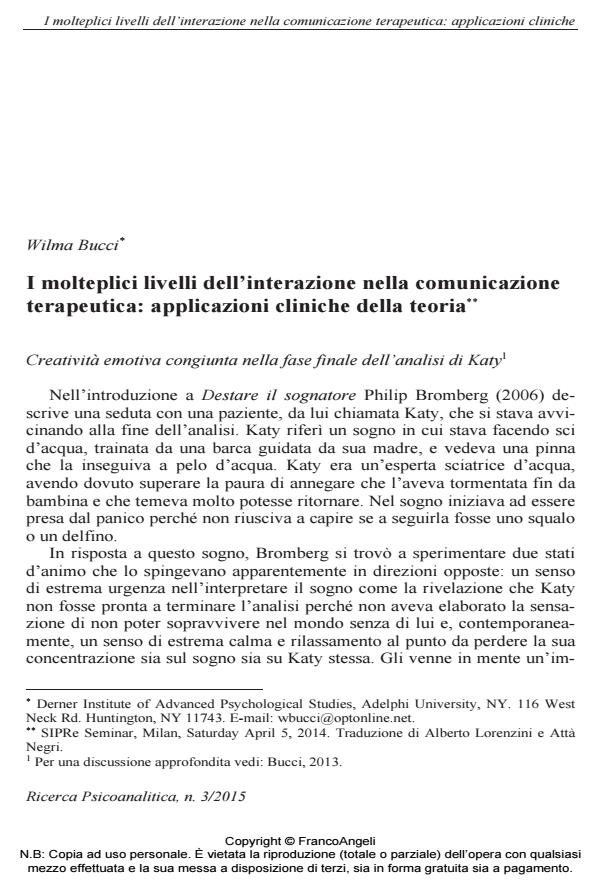Multiple Levels Of Interaction In Therapeutic Communication: Clinical Applications Of The Theory
Journal title RICERCA PSICOANALITICA
Author/s Wilma Bucci
Publishing Year 2015 Issue 2015/3
Language Italian Pages 12 P. 25-36 File size 62 KB
DOI 10.3280/RPR2015-003003
DOI is like a bar code for intellectual property: to have more infomation
click here
Below, you can see the article first page
If you want to buy this article in PDF format, you can do it, following the instructions to buy download credits

FrancoAngeli is member of Publishers International Linking Association, Inc (PILA), a not-for-profit association which run the CrossRef service enabling links to and from online scholarly content.
Reporting some salient passages of four clinical cases the Author provides an iconic and micro-analytical description of the proceeding of the three phases of the referential process - activation, symbolization, reflection - during the analytic session. The final stage of the analysis of Katy, as described by Bromberg, exemplifies the joint and emotional nature of the process creating new meanings in the three phases; the two sensorimotor psychotherapies, described by Ogden, highlight the nature inherently bodily, sensory and motoric of the dissociated emotion schemas that is necessary and useful to activate during the therapy; finally the case of Ann, described by Cornell, provides an example of the indispensability of the activation in the analytic relationship of the bodily, sensory and motoric experiences afflicting the patient to be able to connect them to the symbolic level and thereby to bring about a actual change. At the end are stressed the multiple roles taking the language in each phase of the process referential.
Keywords: Multiple code theory, referential process, joint emotional creativity, embodiment, language
- Il processo referenziale: cognizione o coscienza incarnata? Alberto Lorenzini, in RICERCA PSICOANALITICA 3/2015 pp.67
DOI: 10.3280/RPR2015-003006 - L’apporto dei gruppi a mediazione nella clinica contemporanea. Il metodo Photolangage® Alessandra Micheloni, in Ricerca Psicoanalitica /2022
DOI: 10.4081/rp.2022.644 - Livelli e codici multipli della mente, ovvero vincoli e possibilità della nostra relazione con il mondo Attà Negri, Rachele Mariani, in RICERCA PSICOANALITICA 3/2015 pp.37
DOI: 10.3280/RPR2015-003004 - Commento al caso clinico di A. Micheloni Giuseppe Martorana, in Ricerca Psicoanalitica /2021
DOI: 10.4081/rp.2021.536
Wilma Bucci, I molteplici livelli dell’interazione nella comunicazione terapeutica: applicazioni cliniche della teoria in "RICERCA PSICOANALITICA" 3/2015, pp 25-36, DOI: 10.3280/RPR2015-003003